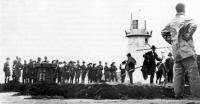Fianna na hÉireann/Na Fianna Éireann
Published in 20th Century Social Perspectives, 20th-century / Contemporary History, Irish Republican Brotherhood / Fenians, Issue 6 (Nov/Dec 2012), Reviews, Revolutionary Period 1912-23, Volume 20
Howth, Sunday 26 July 1914—members of Na Fianna Éireann help to unload and distribute the arms being landed from the Asgard.
Bulmer Hobson founded an organisation that he called ‘Fianna na hÉireann’ on 26 June 1902 at the Catholic Boys’ Hall, Falls Road, Belfast. In Dublin the founders of the Fianna are not so clear, nor the actual date of formation. Curiously, the most precise detail and relevant evidence may come from the pages of the journal of Inighnidhe na hÉireann. The 19 July 1909 issue of Bean na hÉireann detailed the early history of the Irish National Boy Scouts. It was published on the first of each month, so any events described in an issue had to have happened in the previous month. ‘Many of our readers will be glad to learn that a branch of National Boy Scouts has already been formed . . . they call themselves the Red Branch Knights’. This indicates that the Irish National Boy Scouts were in existence in June 1909. The Red Branch Knights were founded by Countess Constance Markievicz sometime before July 1909. The Knights had a number of meetings, including one weekend camp, before August 1909 and another week-long camp later that month. Later that summer there was a meeting at the Sherrard Street home of Frank Molony, brother of Helena Molony, where Hobson, Helena Molony and Markievicz discussed the establishment of the Fianna in Dublin. Hobson presided at a meeting in 34 Lower Camden Street, Dublin, on 16 August 1909 at which the Irish National Boy Scouts changed their name to Fianna na hÉireann. They also elected officers: Hobson as president, Markievicz as vice-president and Padraig Ó Riain as secretary. On 21 August a report in An Claidheamh Soluis noted the meeting and stated that about 100 boys attended. Seán Heuston was the leader of the Fianna on Dublin’s north side, while Con Colbert was the leader on the south side. Louis LeRoux wrote that ‘The Fianna were clearly under the aegis of the IRB Supreme Council, which had gotten the idea from Bulmer Hobson . . . and which appointed Hobson to join the founders of the Fianna in order to keep it under IRB control . . .’.The Fianna played an active part during the 1913 Lockout. A Fianna officer, Patsy O’Connor, died after being struck on the head by a Dublin Metropolitan Police baton while giving first aid to an injured man. When the Volunteers were formed later that year, the value of the work undertaken by the Fianna became obvious. The Fianna were ready and able to train the Volunteers and to transform raw recruits into disciplined soldiers. Fianna drill halls and equipment were at the disposal of the Volunteers. For example, Padraig Ó Riain’s father was the caretaker of the Irish Foresters’ Hall at 41 Rutland Square (now Parnell Square) and he let the Fianna and Volunteers use it. Watching the Ulster Volunteer Force arm, the IRB began drilling here in secret before the formation meeting in Wynn’s Hotel, and members of the Fianna supervised their activities. The Fianna ‘teachers’ were primarily Con Colbert, Michael Lonergan, Éamon Martin and Padraig Ó Riain. Irish Volunteers continued to learn military drill here prior to the Rising. In addition, Countess Markievicz leased Belcamp Park in Raheny as a training centre for larger formation manoeuvres.Some members wore kilts with double-breasted dark green tunics, but senior officers wore breeches and leggings. Their headdress was the Baden-Powell scout hat. They shared a motto with St Enda’s: ‘Strength in our arms, truth on our lips, purity in our hearts’. Patrick Pearse said in February 1914: ‘We believe that Fianna na hÉireann has kept the military spirit alive in Ireland over the past four years, and that if the Fianna had not been founded in 1909 [in Dublin], the Volunteers of 1913 would never have arisen’. HI
Further reading
D. Lawlor, Na Fianna Éireann and the Irish Revolution 1909 to 1923 (Dublin, 2009).Joseph E. Connell is the author of Dublin in rebellion: a directory, 1913–1923 (Lilliput Press, 2006).
















